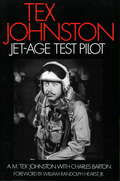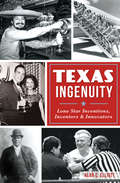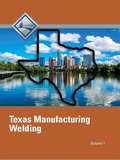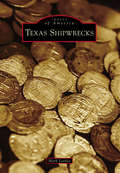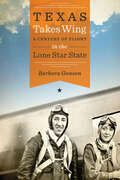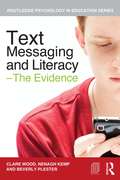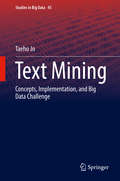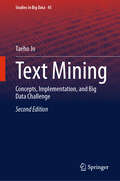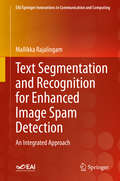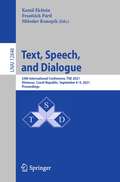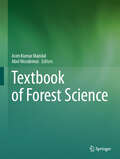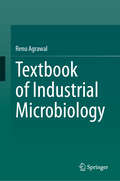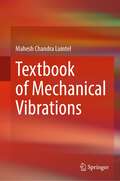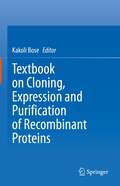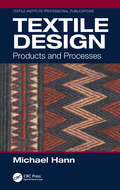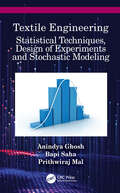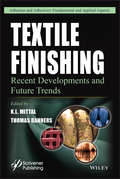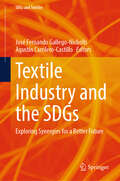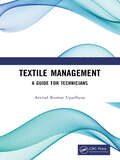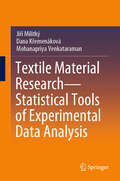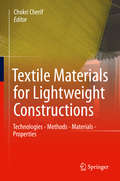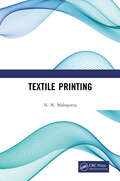- Table View
- List View
Tex Johnston
by A. M. JohnstonOne of America's most daring and accomplished test pilots, Tex Johnston flew the first US jet airplanes and, in a career spanning the 1930s through the 1970s, helped create the jet age at such pioneering aersospace companies as Bell Aircraft and Boeing.
Texas Ingenuity: Lone Star Inventions, Inventors & Innovators
by Alan C. ElliottImagination is bigger in Texas, too. This collection of inspiring and often quirky stories highlights dozens of examples of innovation from Lone Star history. The Hamill brothers devised a better oil well to reach gushers at Spindletop. The first Neiman-Marcus store opened in Dallas in 1907, revolutionizing the retail fashion world. Astroturf emerged at the Astrodome in 1966. Fritos and corn dogs are just two ubiquitous snack foods claimed as Texan originals. Houston native, and civil rights activist, Congresswoman Barbara Jordan rose to national prominence as a voice of unity during the Watergate scandal. Author Alan C. Elliott details these and many more lessons in success in Texas Ingenuity.
Texas Shipwrecks (Images of America)
by Mark LardasThe Texas coastline and offshore waters are flat, shallow, featureless, and filled with shoals. Texas waters are subjected to extreme weather, not just hurricanes and tropical storms but also northers and seasonal gales. This, combined with two centuries of naval warfare off Texas waters, produced many shipwrecks of all sorts, from Spanish treasure fleets to simple working boats. The ships of pirates, navies, cotton traders, immigrants, fishermen, and oil shippers line the Texas coast, cover the sea bottom off Texas, and blanket the bottom of Texas rivers. Each wreck has a story, romantic or repellent, prosaic or unusual, but all intriguing.
Texas Takes Wing: A Century of Flight in the Lone Star State (Bridwell Texas History Series)
by Barbara GansonA history of aviation in Texas that &“brilliantly demonstrates the evolution of flight technology as a harbinger of social change&” (Technology and Culture). In this book, pilot and historian Barbara Ganson brings to life the colorful personalities that shaped the phenomenally successful development of the aviation industry in the Lone Star state. Weaving stories and profiles of aviators, designers, manufacturers, and those in related services, Texas Takes Wing covers the major trends that propelled Texas to the forefront of the field. Covering institutions from San Antonio&’s Randolph Air Force Base (the West Point of this branch of service) to Brownsville&’s airport with its Pan American Airlines instrument flight school (which served as an international gateway to Latin America as early as the 1920s) to Houston&’s Johnson Space Center, home of Mission Control for the US space program, the book provides an exhilarating timeline and engaging history of dozens of unsung pioneers as well as their more widely celebrated peers. Drawn from personal interviews as well as major archives and the collections of several commercial airlines, including American, Southwest, Braniff, Pan American Airways, and Continental, this sweeping history captures the story of powered flight in Texas since 1910. With its generally favorable flying weather, flat terrain, and wide-open spaces, Texas has more airports than any other state and is often considered one of America&’s most aviation-friendly places. Texas Takes Wing also explores the men and women who made the region pivotal in military training, aircraft manufacturing during wartime, general aviation, and air servicing of the agricultural industry. The result is a soaring history that will delight aviators and passengers alike. Includes photos
Text Comprehension And Learning
by Wolfgang Schnotz Bernadette Van Hout-WoltersThis book deals with the significance of different text structures and its cognitive processing in learning from texts. It discusses the effect of learning abilities and attitudes for learning from texts, and focuses on the significance of processing and learning strategies for text comprehension.
Text Messaging and Literacy – The Evidence
by Clare Wood Nenagh Kemp Beverly Plester"Well thought out and timely. This is the leading group in the world working on texting and literacy, and they have a strong track record of publications. It would also be the first book, as they say, to deal with the subject at an academic level. The focus on education is important, as this is where most of the anxieties lie. It will be a major step forward in creating a new climate." Professor David Crystal, author of The Cambridge Encyclopaedia of Language and The Cambridge Encyclopaedia of the English Language, Television consultant and presenter As children are given mobile phones at increasingly younger ages, there is considerable media coverage of claims that mobile phones, and text messaging in particular, are responsible for declining levels of literacy in children and young people. Such claims are often adopted wholesale by teachers and parents, despite the fact that there is an empirical literature which has failed to find a basis to these claims, and to the contrary has found that text messaging is supporting children’s literacy skills. Written by leading international researchers Text Messaging and Literacy presents an overview and discussion of the academic evidence for and against use of text messaging and mobile phones in supporting literate activity and discusses what conclusions we can and should draw about the impact of mobile phones, and their potential role in education. Areas covered include: the rise of texting and media reactions; children’s reading, spelling and texting; text messaging of children with language difficulties; using mobile phones for literacy development; texting and literacy skills in adolescents and adults; spelling and grammar in texting and beyond; the future of texting. In challenging existing assumptions the authors present the cutting edge of international research, highlighting their own studies involving children of all ages, adolescents and adults. This ground breaking book is essential reading for both researchers and students in education, educational psychology, literacy and new media and it’s impact on learning.
Text Mining: Concepts, Implementation, and Big Data Challenge (Studies in Big Data #45)
by Taeho JoThis book discusses text mining and different ways this type of data mining can be used to find implicit knowledge from text collections. The author provides the guidelines for implementing text mining systems in Java, as well as concepts and approaches. The book starts by providing detailed text preprocessing techniques and then goes on to provide concepts, the techniques, the implementation, and the evaluation of text categorization. It then goes into more advanced topics including text summarization, text segmentation, topic mapping, and automatic text management.
Text Mining: Concepts, Implementation, and Big Data Challenge (Studies in Big Data #45)
by Taeho JoThis popular book, updated as a textbook for classroom use, discusses text mining and different ways this type of data mining can be used to find implicit knowledge from text collections. The author provides the guidelines for implementing text mining systems in Java, as well as concepts and approaches. The book starts by providing detailed text preprocessing techniques and then goes on to provide concepts, the techniques, the implementation, and the evaluation of text categorization. It then goes into more advanced topics including text summarization, text segmentation, topic mapping, and automatic text management. The book features exercises and code to help readers quickly learn and apply knowledge.
Text Segmentation and Recognition for Enhanced Image Spam Detection: An Integrated Approach (EAI/Springer Innovations in Communication and Computing)
by Mallikka RajalingamThis book discusses email spam detection and its challenges such as text classification and categorization. The book proposes an efficient spam detection technique that is a combination of Character Segmentation and Recognition and Classification (CSRC). The author describes how this can detect whether an email (text and image based) is a spam mail or not. The book presents four solutions: first, to extract the text character from the image by segmentation process which includes a combination of Discrete Wavelet Transform (DWT) and skew detection. Second, text characters are via text recognition and visual feature extraction approach which relies on contour analysis with improved Local Binary Pattern (LBP). Third, extracted text features are classified using improvised K-Nearest Neighbor search (KNN) and Support Vector Machine (SVM). Fourth, the performance of the proposed method is validated by the measure of metric named as sensitivity, specificity, precision, recall, F-measure, accuracy, error rate and correct rate. Presents solutions to email spam detection and discusses its challenges such as text classification and categorization;Analyzes the proposed techniques’ performance using precision, F-measure, recall and accuracy;Evaluates the limitations of the proposed research thereby recommending future research.
Text, Speech, and Dialogue: 24th International Conference, TSD 2021, Olomouc, Czech Republic, September 6–9, 2021, Proceedings (Lecture Notes in Computer Science #12848)
by Kamil Ekštein František Pártl Miloslav KonopíkThis book constitutes the proceedings of the 24th International Conference on Text, Speech, and Dialogue, TSD 2021, held in Olomouc, Czech Republic, in September 2021.*The 2 keynote speeches and 46 papers presented in this volume were carefully reviewed and selected from 101 submissions. The topical sections "Text", "Speech", and "Dialogue" deal with the following issues: speech recognition; corpora and language resources; speech and spoken language generation; tagging, classification and parsing of text and speech; semantic processing of text and speech; integrating applications of text and speech processing; automatic dialogue systems; multimodal techniques and modelling, and others. * Due to the COVID-19 pandemic the conference was held in a "hybrid" mode.
Textbook of Forest Science
by Asim Kumar Mandal Abel NicodemusThis textbook presents the latest knowledge on various disciplines of forestry science presented in 39 chapters. Each chapter presents a reappraisal of theory and practice, applications and future scope of subject area. It is a single point reference for updated information on both traditional and contemporary areas of forestry. Some of the disciplines covered in the book are biotechnology, remote sensing, forest certification, forest management, forest hydrology, climate change, plantation and urban forestry, biodiversity and genetic resources conservation, wildfire science, seed science and quality seed production and ecosystem services. The book primarily serves as an advanced textbook of forest science for students of forestry at all levels. The science of forestry is receiving much more attention of the researchers, policy makers, andl public than ever before because of growing awareness of vital importance of forests in amelioration of world environment. This book is a comprehensive collection of existing and new methods including outcome and future possibilities of forest science. This book benefits undergraduate and postgraduate students, professional researchers, teachers, practicing foresters, and policy planners. The book also encourages the public to understand the relevance of forest science to overcome the contemporary economic and environmental challenges.
Textbook of Industrial Microbiology
by Renu AgrawalTextbook of Industrial Microbiology is a groundbreaking book encompassing the entire spectrum of industrial microbiology, filling a significant void in the field. From tracing its historical roots to exploring primary and secondary metabolites, down to downstream processing and product recovery, this book offers a cohesive narrative previously unavailable in a single resource. The meticulously structured chapters discuss the systematic journey of metabolites, covering the screening of microorganisms, preservation techniques, fermentation media, fermenters, and the significance of industrially vital secondary metabolites. It provides insights for industrialists, elucidating crucial process parameters essential for comprehending and optimizing microbial processes. This textbook serves as a great resource for undergraduate, and postgraduate students, researchers, industrialists, and technologists
Textbook of Mechanical Vibrations
by Mahesh Chandra LuintelThis textbook covers the fundamentals and applications of mechanical vibrations and is useful for both undergraduate and postgraduate courses. It provides a concise and clear presentation of dynamics and vibrations including many examples to provide instant illustration and applications of the mathematical relations obtained. It contains self-explanatory sketches, graphs, and figures to curtail long text. Numerous illustrated examples, exercises, and problems at the end of each chapter serve as good sources to grasp the basic principles presented in the text. Review questions and sufficient problems have also been included at the end of each chapter with answer keys for self evaluation. This textbook can also be used as a reference book by researchers and professionals interested in vibrations.
Textbook of Seismic Design: Structures, Piping Systems, and Components
by Ajit Kumar Verma Hari Prasad Muruva G. R. ReddyThis book focuses on the seismic design of Structures, Piping Systems and Components (SSC). It explains the basic mechanisms of earthquakes, generation of design basis ground motion, and fundamentals of structural dynamics; further, it delves into geotechnical aspects related to the earthquake design, analysis of multi degree-of-freedom systems, and seismic design of RC structures and steel structures. The book discusses the design of components and piping systems located at the ground level as well as at different floor levels of the structure. It also covers anchorage design of component and piping system, and provides an introduction to retrofitting, seismic response control including seismic base isolation, and testing of SSCs. The book is written in an easy-to-understand way, with review questions, case studies and detailed examples on each topic. This educational approach makes the book useful in both classrooms and professional training courses for students, researchers, and professionals alike.
Textbook on Cloning, Expression and Purification of Recombinant Proteins
by Kakoli BoseThis book is immensely useful for graduate students as well as researchers to understand the basics of molecular biology and Recombinant DNA Technology. It provides a comprehensive overview of different approaches for the synthesis of recombinant proteins from E. coli including their cloning, expression and purification. Recent advances in genomics, proteomics, and bioinformatics have facilitated the use of Recombinant DNA Technology for evaluating the biophysical and biochemical properties of various proteins. The book starts with an introductory chapter on gene cloning, protein expression and purification and its implication in current research and commercial applications. Each chapter provides a lucid set of principles, tools and techniques for both students and instructors. The protocols described have been aptly exemplified, and troubleshooting techniques have been included to aid better understanding. Moreover, the set of questions at the end of each chapter have been particularly formulated to help effective learning.
Textile Design: Products and Processes (Textile Institute Professional Publications)
by Michael HannThis book includes fundamentals of textile processing technology with explanation of craft techniques, various stages of processing fibres and yarns with useful, readily understandable, line drawings. Fibrous types, dyes, yarns and cloths have been explained and material is supported by glossary and explanation of processing stages from fibre to finished cloth. Further, the considerations of relevance to the development and preparation of a design collection are outlined and discussed. Various testing procedures, including fibre, yarn and cloth identification methods, and important innovations in textile products and processing are identified and explained as well. Focused mainly on the needs of students specializing in textile or fashion design, at first year undergraduate university level, this book: Covers all stages from fibre to finished cloth. Discusses various stages of processing fibres and yarns. Explains fibrous types, dyes, yarns and cloths supported by relevant glossary. Presents explanations of both tactile and aesthetic aspects of textiles used in clothing.
Textile Engineering: Statistical Techniques, Design of Experiments and Stochastic Modeling
by Anindya Ghosh Prithwiraj Mal Bapi SahaFocusing on the importance of the application of statistical techniques, this book covers the design of experiments and stochastic modeling in textile engineering. Textile Engineering: Statistical Techniques, Design of Experiments and Stochastic Modeling focuses on the analysis and interpretation of textile data for improving the quality of textile processes and products using various statistical techniques. FEATURES Explores probability, random variables, probability distribution, estimation, significance test, ANOVA, acceptance sampling, control chart, regression and correlation, design of experiments and stochastic modeling pertaining to textiles Presents step-by-step mathematical derivations Includes MATLAB® codes for solving various numerical problems Consists of case studies, practical examples and homework problems in each chapter This book is aimed at graduate students, researchers and professionals in textile engineering, textile clothing, textile management and industrial engineering. This book is equally useful for learners and practitioners in other science and technological domains.
Textile Finishing: Recent Developments and Future Trends
by K. L. Mittal Thomas BahnersTextiles have been historically and traditionally used to make clothes, but even in ancient times there were technical textiles for making sails, tents, etc. Today, technical textiles are used in various industries for a host of purposes and applications. Recently, there have been exciting developments on various fronts in the textile field to impart novel and innovative functionalities to textiles, e.g., easy-to-clean or dirt-repellent, flame retardancy, anti-bacterial, and fog-harvesting properties, to name a few. Also, textiles for electronics based on graphene, CNTs and other nanomaterials, conductive textiles, textiles for sensor function, textile-fixed catalysts, textiles for batteries and energy storage, textiles as substrates for tissue engineering, and textiles for O/W separation have appeared in the literature. All this has been possible through adopting novel ways for finishing textiles, e.g., by appropriate surface modification techniques, and utilizing biomimetic concepts borrowed from nature. This unique book entitled “Textile Finishing: Recent Developments and Future Trends” is divided into four parts: Part 1: Recent Developments/Current Challenges in Textile Finishing; Part 2: Surface Modification Techniques for Textiles; Part 3: Innovative Functionalities of Textiles; Part 4: Fiber-Reinforced Composites. The topics covered include: Antimicrobial textile finishes; flame retardant textile finishing; “self-cleaning” or easy-to-clean textiles; metallization of textiles; atmospheric pressure plasma, and uv-based photochemical surface modification of textiles; tunable wettability of textiles; 3D textile structures for fog harvesting; textile-fixed catalysts; medical textiles as substrates for tissue engineering; and fiber-reinforced “green” or “greener” biocomposites and the relevance of fiber/matrix adhesion.
Textile Industry and the SDGs: Exploring Synergies for a Better Future (SDGs and Textiles)
by José Fernando Gallego-Nicholls Agustín Carrilero-CastilloThis book offers an exploration of the textile industry and their relationship to the Sustainable Development Goals (SDGs), catering specifically to academic researchers and providing a roadmap for aligning aligning textile research with the SDGs. It covers a wide range of topics, starting with an overview of the SDGs and their relevance to the textile industry. It examines the environmental footprint of textiles, including issues related to raw material sourcing, manufacturing processes, and waste management. Additionally, it explores the social and economic aspects of textiles, such as labor conditions, fair trade, and responsible consumption. One of the main focuses of this book is the role of innovation and technology in advancing sustainable textiles. It discusses emerging materials and technologies that promote circularity, reduce environmental harm, and enhance social well-being. Furthermore, it explores the potential of digitalization, artificial intelligence, and data analytics in optimizing textile production, distribution, and consumption patterns. This book also addresses the challenges and opportunities associated with sustainable textile supply chains. It analyzes the complexities of global value chains, the need for transparency and traceability, and the importance of collaboration among stakeholders. Furthermore, it highlights strategies for promoting sustainable fashion, encouraging responsible consumption, and fostering circular business models. By delving into these topics, this book aims to solve several key problems faced by academic researchers in the field of textiles and sustainability. It provides a holistic understanding of the SDGs and their integration into textile research, helping researchers align their work with broader sustainability objectives. It offers insights into the latest innovations and technologies, enabling researchers to explore cutting-edge solutions for sustainable textiles. Additionally, it presents case studies and best practices from industry leaders, inspiring researchers to undertake impactful research and contribute to positive change. This book is intended for academic researchers, as well as practitioners, specializing in textiles, sustainability, and related fields. It serves as a valuable resource for professors, postgraduate students, and professionals seeking to deepen their knowledge of the interplay between textiles and the SDGs. It encourages critical thinking, fosters interdisciplinary collaboration, and equips researchers with the tools and insights necessary to drive sustainable transformations within the textile industry and beyond.
Textile Management: A Guide for Technicians
by Arvind Kumar UpadhyayThis book covers the core principles of managing textiles, covering everything from sourcing and production to distribution and sustainability. The objective of this book is to provide relevant information about critical business aspects of the textile industry and its ancillary tools. It covers important concepts of business in a brief and simplified, yet practical way through examples in the form of reports, formats, figures related to respective subjects. Print edition not for sale in South Asia (Bangladesh, Bhutan, India, Nepal, Pakistan and Sri Lanka)
Textile Material Research—Statistical Tools of Experimental Data Analysis
by Mohanapriya Venkataraman Jiří Militký Dana KřemenákováThis book presents the effective combination of mathematical statistics, general metrology, and textile metrology to allow data analysis with regard to the evaluation of parameters of fibrous structures. Specialists working in material sciences, where fibrous structures are used, comprehensively understand the specifics of the fabric evaluation and manage in the context of rational use of selected mathematical and statistical methods. In this book, selected methods that are advantageous for data analysis, regardless of whether they are elementary or advanced are presented. The so-called computer-intensive methods are used in many situations when classical statistics is unable to offer a solution, or the solution is too complicated.
Textile Materials for Lightweight Constructions
by Chokri CherifIn this book, experts on textile technologies convey both general and specific information on various aspects of textile engineering, ready-made technologies, and textile chemistry. They describe the entire process chain from fiber materials to various yarn constructions, 2D and 3D textile constructions, preforms, and interface layer design. In addition, the authors introduce testing methods, shaping and simulation techniques for the characterization of and structural mechanics calculations on anisotropic, pliable high-performance textiles, including specific examples from the fields of fiber plastic composites, textile concrete and textile membranes. Readers will also be familiarized with the potential offered by increasingly employed textile structures, for instance in the fields of composite technology, construction technology, security technology and membrane technology.
Textile Mechanisms in Spinning and Weaving Machines
by Ganapathy NagarajanThis book discusses the mechanics in textile machinery in spinning, weaving and knitting processes. It is a useful resource for developing an analytical thinking about the machineries by providing information about the various mechanisms involved. The subject matter of this book includes – Gear trains Equations of movement Resolution of forces Principle of moments Stress, strain and elasticity Print edition not for sale in South Asia (India, Sri Lanka, Nepal, Bangladesh, Pakistan and Bhutan)
Textile Printing
by N. N. MahapatraTextile printing is the process of applying colour to fabric in definite patterns or designs. This book covers different methods of textile printing like hand block printing, perrotine printing, engraved copperplate printing, roller-cylinder-machine printing, stencil printing, screen printing, digital textile printing, flexo-textile printing, and discharge printing. Print edition not for sale in South Asia (Bangladesh, Bhutan, India, Nepal, Pakistan and Sri Lanka)
